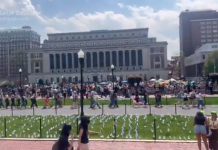Romania’s resourceful Saxon community are promoting their region with bike rides in the meadows of southern Transylvania, UNESCO-protected fortified churches and local rhubarb.
TV personality Andreea Marin launched this year’s Haferland Festival on Wednesday, an event that embraces and promotes 10 villages across a swath of gently rolling hills across central Romania.
The area which is a like a slit on the map in the heart of Romania got its name as grapes wouldn’t grow there due to the harsh climate. So the industrious Saxons planted oats.
The three-day festival, now in its 12th year, has become a magnet for politicians and princes as well as thousands of ordinary tourists. It showcases Saxon culture, traditions and hospitality with book launches, village balls, brass bands, dancing, traditional cuisine, pottery-making and open-air dining.
This year it takes place under the high patronage of His Serene Highness Prince Philipp von und zu Liechtenstein and the Royal Family of Romania, the first time they have officially supported the event.
The festival is held in Crit, Viscri (where King Charles III has a house), Mesendorf, Saschiz, Homorod, Archita, Roades, Cloasterf and Bunesti and the town of Rupea, in south Transylvania where the Saxons settled in the 12th century. After communism, the villages emptied as ethnic Germans moved abroad for more opportunities.
The Haferland Festival, however, is putting the region in the spotlight and slowly reviving the local economy.
Veronica Schmidt, the deputy president of the Veronica and Michael Schmidt Foundation, which created the event, said she became involved in the project not only to help her husband, entrepreneur Michael Schmidt but also because “roots count.”
Roots were a common theme during the press conference at the Dimitrie Gusti Village Museum in Bucharest.
“We don’t hold the roots; the roots hold us,” said Caroline Fernolend, the Executive Director of Mihai Eminescu Trust and one of the most renowned activists for the conservation of Saxon traditions and patrimony. “Roots kept me here and the duty to my forefathers who left us such a rich patrimony.”
“In 1989 I had a dream that the villages of Haferland would be recognized. But I could never dream what happened would happen. I want people who live in these villages to have better lives and to increase the visibility of the Saxons,” she added.
The Saxons are traditionally a welcoming, inclusive community and Michael Schmidt noted that the festival is popular with Romanians and English people who are curious or charmed by the community and their traditions, not just returning Saxons and Germans.
“We are honored that the Haferland Festival opens at ‘the museum on the boulevard’,” said Paulina Popoiu, the museum’s curator. The museum features village houses of different architectural styles in a park in northern Bucharest, including a Saxon house.
“Saxons are coming back to Romania thanks to the Village Museum.”
In reality, large numbers of Saxons are not returning to their homelands after most left 30 or 40 years ago. But the Haferland Festival has brought greater visibility to the small ethnic community, which is known for its industriousness and ‘civilizing influence,’ on the Romanian and Hungarian populations they share Transylvania with.
Newly retired British Ambassador Andrew Noble, who speaks German and Romanian and is a long-time supporter of the festival, has joined the team to share his ideas, vision and experience to attract more attention to the Saxon heritage.
“Haferland is a jewel that you can’t find in Germany,” Mr. Noble told Universul.net. “ German speakers in Europe should come and see it. “
“This is a dream for a retired diplomat,” he said in Romanian of his new role.
Cristi Gherghiceanu , the Executive President of Adept, a biodiversity conservation and rural development NGOm said the area offered bike rides and hikes across the meadows for tourists and the annual Rhubarb Festival, held in the second week of May.
This year visitors will be able to view the renovation of the medieval fortress at Saschiz and even sample a traditional wedding menu.
“We see, we listen, and we taste Saschiz,” he said. “The Saxons are stubborn and committed, here for the long haul,” he said.
The emphasis is now on sustainability and making money from the patrimony to keep people in the villages and have the necessary infrastructure for tourism.
“We all need incomes and if people can’t see that the old house or fortified church can bring them money, they won’t be motivated to maintain them,” Ms. Fernolend said. “People can earn money from gastronomy, tourism and guest houses.”
The festival runs from August 8-11, 2024.
Press release: Haferland Week 2024: the most beloved festival of the Transylvanian Saxons opens its doors on August 8, with dozens of events with free access for all ages
- The twelfth edition of the Haferland Week, the most beloved cultural and ethnological festival of the Saxon communities in Transylvania, will take place between August 8-11, 2024 in ten localities in Transylvania: Archita, Saschiz, Homorod, Rupea, Criț, Roades, Meșendorf, Cloașterf, Bunești and Viscri;
- At this year’s edition of the festival, about 10,000 visitors are expected both from Romania and from countries such as Germany, Austria, the Netherlands or the United States. Access is free;
- Among the most anticipated events are the 700th anniversary of the first documentary attestation of Rupea Fortress, one of the most important and impressive medieval monuments in Transylvania, today completely restored;
- The event will take place under the high patronage of His Serene Highness Prince Philipp von und zu Liechtenstein, member of the Princely House ruled this state for over 200 years;
- Also, the Haferland Week will take place, for the first time, under the auspices of the Royal Family of Romania;
- Also for the first time, the festival has partnered with The Duke of Edinburgh’s International Award Romania foundation, an organization that delivers a global program for young people aged between 14 and 24. Patronized globally by HRH The Duke of Edinburgh and nationally by Her Majesty Margareta, Custodian of the Romanian Crown, the program has been operating in Romania for over 10 years. By developing transferable skills, raising fitness levels, cultivating a sense of adventure and volunteering in their community, the Award program helps young people grow and excel;
- Festival participants will be able to enjoy visiting historical monuments such as fortified churches, traditional households (including the property owned in Viscri by King Charles), concerts, balls and performances with traditional Saxon music, film screenings, conferences with the public, exhibitions, workshops for children and adults, guided tours, visits to local farms and households, organic tastings and much more.
The twelfth edition of the Haferland Week is organized in partnership with „Dimitrie Gusti” National Village Museum in Bucharest, CEC Bank, Hochland, Bosch Foundation Romania, Rompetrol, Geiger, Aqua Carpatica, Samburesti Domains, Automobile Bavaria and MHS Truck & Bus, media partner KISS FM.
The co-organizers of the festival, M&V Schmidt Foundation, Tabaluga / Peter Maffay Stiftung Foundation, Democratic Forum of Germans in Transylvania, Association of Transylvanian Saxons in Germany, Evangelical Church C.A. in Romania, through the District Consistories of the Evangelical Church C.A. Brasov and Sighisoara, are supported by local partners: Mihai Eminescu Trust Foundation, Fundatia ADEPT Transilvania, Nowero Association, Rupea City Hall, Discover Archita Association, Vânători City Hall (Vânători County) Mures), Saschiz Women’s Neighborhood Association and Bunești City Hall (Bunești County). Brasov).
‘If Haferland didn’t exist, it would have to be invented’- UK ambassador

















